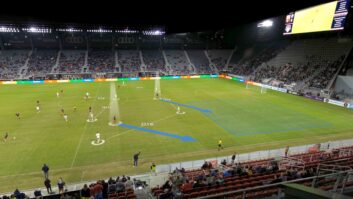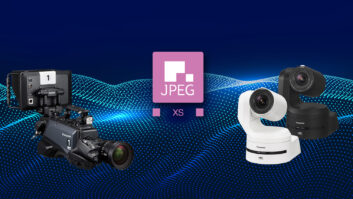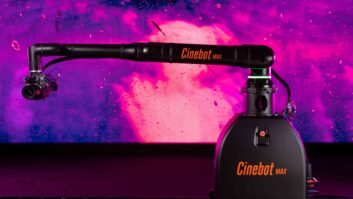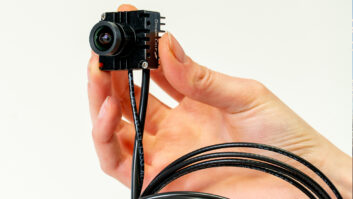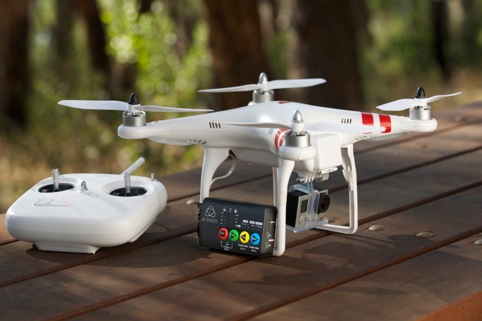
Manufacturers of recorders launching cameras is a growing trend. Following Blackmagic Design’s lead, this year AJA Video Systems and Codex have entered the camera market. While AJA’s Cion is a large, shoulder-mounted camcorder, the new Codex Action Cam is an ultra-compact, all-in-one, digital cinema camera and recording package for 2D or S3D production.
The Action Cam camera head will cost about $10,000, while various bundles (camera head, recorder/camera control unit/dock/capture drives) will start at about $28,000 when the cameras start shipping over the summer.
The camera has been designed for use as an action, witness or PoV camera system, particularly as a companion camera for larger cameras.
It “is a simple, no-nonsense, out-of-the-box camera and recording system,” said Marc Dando, Codex managing director. “In one compact package the tiny camera shoots exceptional images and, unlike other small cameras, has a rock-solid workflow behind it – allowing cinematographers to shoot with confidence in new and ever more creative ways.”
Besides the small camera head the system will include a Codex Camera Control Recorder offering full remote control of the camera, plus the proven Codex workflow, including Raw capture at up to 60fps. It is claimed to resolve “the common issues of syncing associated with small format camera solutions. Multiple camera heads can be in sync with other main unit cameras like the ARRI Alexa.” Shutter sync, Genlock and LTC allow the Action Cams to be easily synchronised with other cameras.
Other features include: wide dynamic range; 14-bit image processing; a 12-bit Raw output; and debayering. It is also claimed to perform “exceptionally well in normal and extreme lighting conditions”.
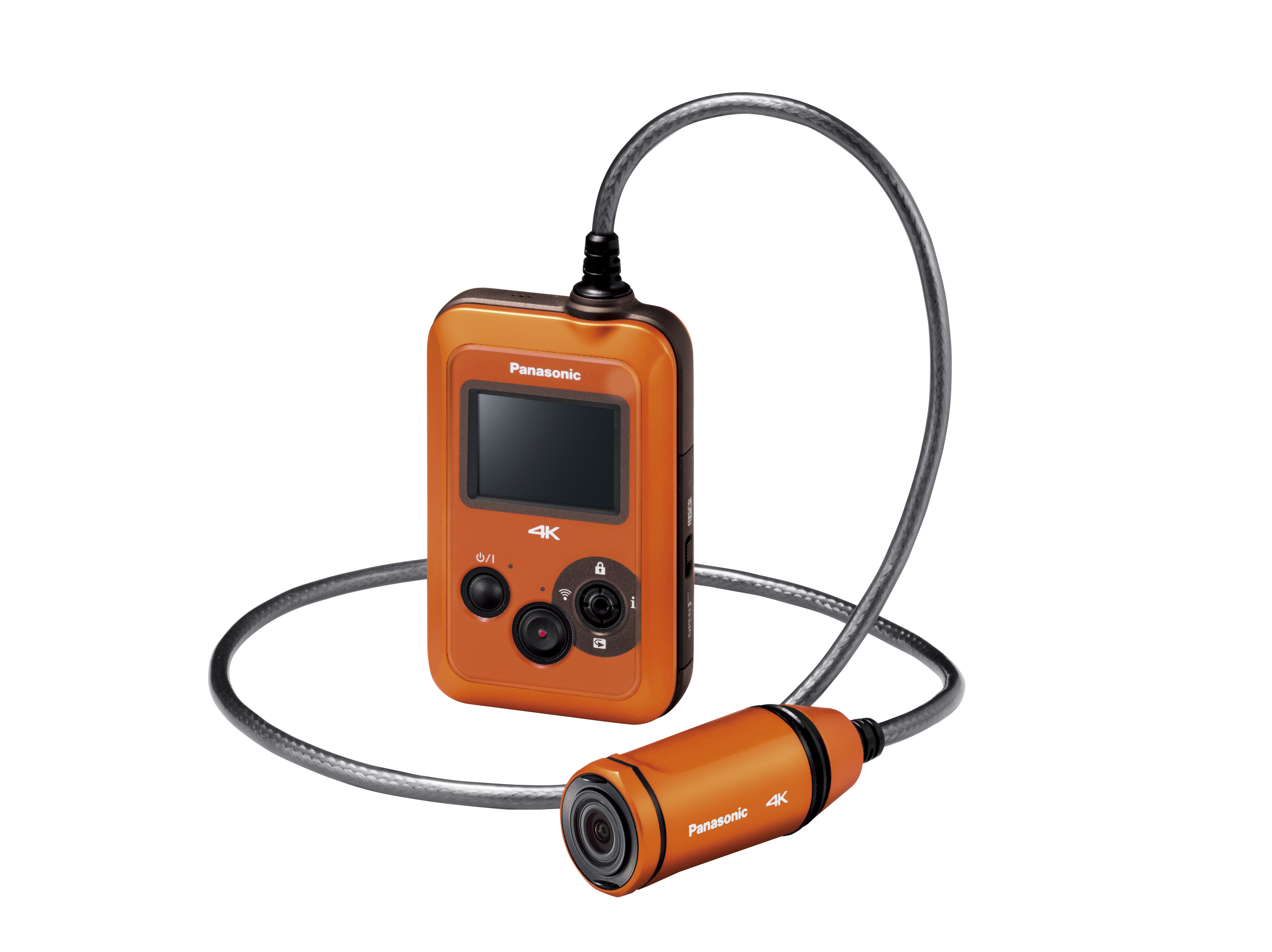
The camera uses a 2⁄3-inch CCD sensor that boasts low signal-to-noise ratio, temperature stability, no visible fixed-pattern-noise, and none of the rolling shutter effects common on many CMOS sensor cameras. The camera takes C-mount lenses, but there are also EF, PL and B4-mount adaptors, for a wide choice of lenses.
The Camera Control Recorder can be used to operate the camera head and adjust white balance, exposure and frame rates. Delivery formats, via Codex media stations or Codex Vault workflows, include Apple ProRes and Avid DNxHD, uncompressed and H.264.
For stereo 3D applications two camera heads can be connected to the Camera Control Recorder, and the signals will undergo identical processing, to deliver completely synchronous S3D output with identical image properties, such as white balance and contrast.
Compact reaches Xtreme speeds
Grass Valley has extended its range of LDX Compact series cameras with two new high-speed models, the LDX Compact XtremeSpeed (LDX Compact XS) 6x ultra slow-motion and the LDX Compact HiSpeed (LDX Compact HS) 3x super slow-motion camera systems.
“All of the typical video interfaces are available directly from the camera head, which offers an HDMI interface for connecting any HD display with an HDMI or DVI interface for camera viewfinder or monitoring,” said Klaus Weber, director of camera technology, Grass Valley. They have been designed to compliment the larger LDX Series cameras that are popular for live OB and studio production, but are small enough to mount on compact remote heads, on rail systems, as Spidercams or gyroscopic stabilising systems.
“The LDX Compact camera system is used in many applications around the world, including on robotic heads for in-studio news production, used together with wireless transmission equipment on Steadicam systems and fixed mounted camera positions for in-studio and on-location. Our customer applications include virtual studios, news studios and live sports,” he added.
The high-speed models are particularly interesting, especially the LDX Compact XS, which delivers 6x ultra slow-motion in 1080i and 720p, and 3x in 1080p, as well as a standard 1x output for live video. It “delivers instant time-to-air with no internal camera storage requirement, and is the first ultra slow-motion camera to integrate seamlessly into live workflows with higher than 3x speeds,” claimed Weber. The 3x LDX Compact HS camera system is software upgradable to the LDX Compact XS.
Reality bites
Although miniature cameras are usually seen as adjuncts to a larger camera operation, they are increasingly used as the sole cameras on multi-camera productions.
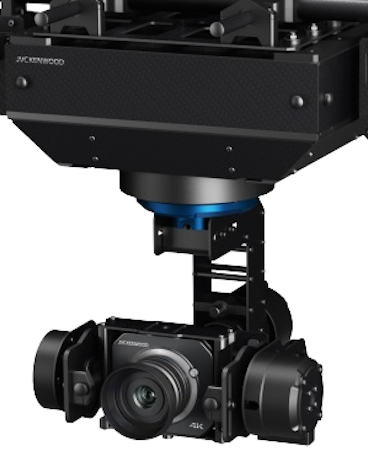
In the last year, there has been a surge in fixed rig production with many series shot using discreet camera heads and pan/tilt/zoom cameras. Production specialist Minicams has used such rigs on Secret Eaters, Hotel of Mum and Dad, Motorway Cops and Barely Legal Drivers, and recently invested in a new recording system, the Quadrus Ingest Machine for multi-channel recording, which promises to deliver immediate workflow efficiencies and enhanced creative output.
“Traditionally, multi-channel capture has been the preserve of OB facilities and broadcasters. By investing in Quadrus Ingest Machine, we can now offer secure eight-channel recording to an HD codec that suits the customers’ workflow,” said Nick McLachlan, MD of Minicams.
The Quadrus system, distributed by Holdan, was used for Channel 5’s Medicating Lewisham, where four individual streams were captured as Avid DNxHD. This meant there was no need to transcode prior to editing. It also integrated with the Avid ISIS storage used on the production and could check clips into the Interplay asset management system.
Alternative means of recording weren’t as suitable for fast turnaround location shoots. Racks of individual recorders could be bulky and inflexible, while broadcast servers are not only expensive but better suited to use in a studio or OB truck. Quadrus, however, is PC-based “so it’s light, portable and easily maintained. It works with local or network storage, and as it runs on a standard workstation, it can be configured to our changing needs,” McLachlan explained.
Minicams bought the Quadrus system (from Altered Images) fully configured on an HP Z820 workstation, and it means there is no need for individual decks to record each camera output, which would also require regularly swapping out recording media and then manually ingesting and logging files from each card. With Quadrus, each channel is recorded to a central storage silo, with production management systems able to manage every asset during the shoot. The software also supports chase editing, allowing editors to cut the programme as it is recording.
Minicams now plans to integrate the software more fully with its portable production units. “Currently the Live Cut feature allows us to create a basic EDL on the fly via a keyboard, which can be read by most NLEs. We’re now working on ways to tie the vision mixer into the live recording workflow. By creating dynamic sequences as well as an EDL at the production stage – instead of in the edit suite – the director will potentially save considerable time in post,” he said.
The system was also used for a new Channel 5 fly-on-the-wall series about a health centre, GPs Behind Closed Doors, using Panasonic HE60S PTZ cameras controlled remotely over Cat-5 cable.
4K action cam
The new Panasonic HX-A500 is the first Ultra HD 25p/30p wearable camcorder, and can also record HD at 50p.
It is waterproof (to 3m for 30 minutes) and dustproof, and uses the umbilical design Panasonic prefers for miniature cameras. The 31g camera is connected via a cable to the 119g operating and recording unit, which has a built-in 1.5-inch LCD monitor.
The $400/£380 HX-A500 can connect via Wi-Fi to a smartphone or tablet, and be used with Panasonic’s Image App to record and edit video remotely.
It uses a new high-speed image processor, Crystal Engine Pro+, with a new high sensitivity BSI sensor, and offers levelling correction, image stabilisation and loop recording.
Aerial offerings
JVC introduced the world’s first handheld 4K camcorder, the GY-HMQ10, in 2012, but has only now begun to build on that with further 4K cameras. It showed prototypes at NAB based around a new 13.6MP 4K CMOS image sensor developed by its sister company, AltaSens.
Two of the offerings were compact: a two-piece mini 4K camera, the GW-SPLS1, which records to SDHC media, and offers IP control and viewing; and the GW-GBLS1 small-head camera gimbal system. This has a 4K camera unit with a Super 35mm CMOS sensor that delivers 4096×2160 or 3840×2160 resolution at up to 60p.
It is housed in a gimbal designed using proprietary technology developed by JVC, and records locally to SDXC or SDHC media cards. However, the base of gimbal also houses wireless technology with the same IP capabilities as the new GY-HM890 ProHD shoulder-mount camcorder.
The HM890 has a built-in streaming engine with FTP and 4G LTE connectivity to allow live HD transmission directly from the camera without needing an external bonded cellular system. It uses a built-in processor with proprietary algorithms, advanced content-aware error-correction and JVC’s new Advanced Streaming Technology to maximise bandwidth, provide realtime feedback of streaming status and compensate for up to 30% packet loss to ensure reliable transmission under difficult conditions.
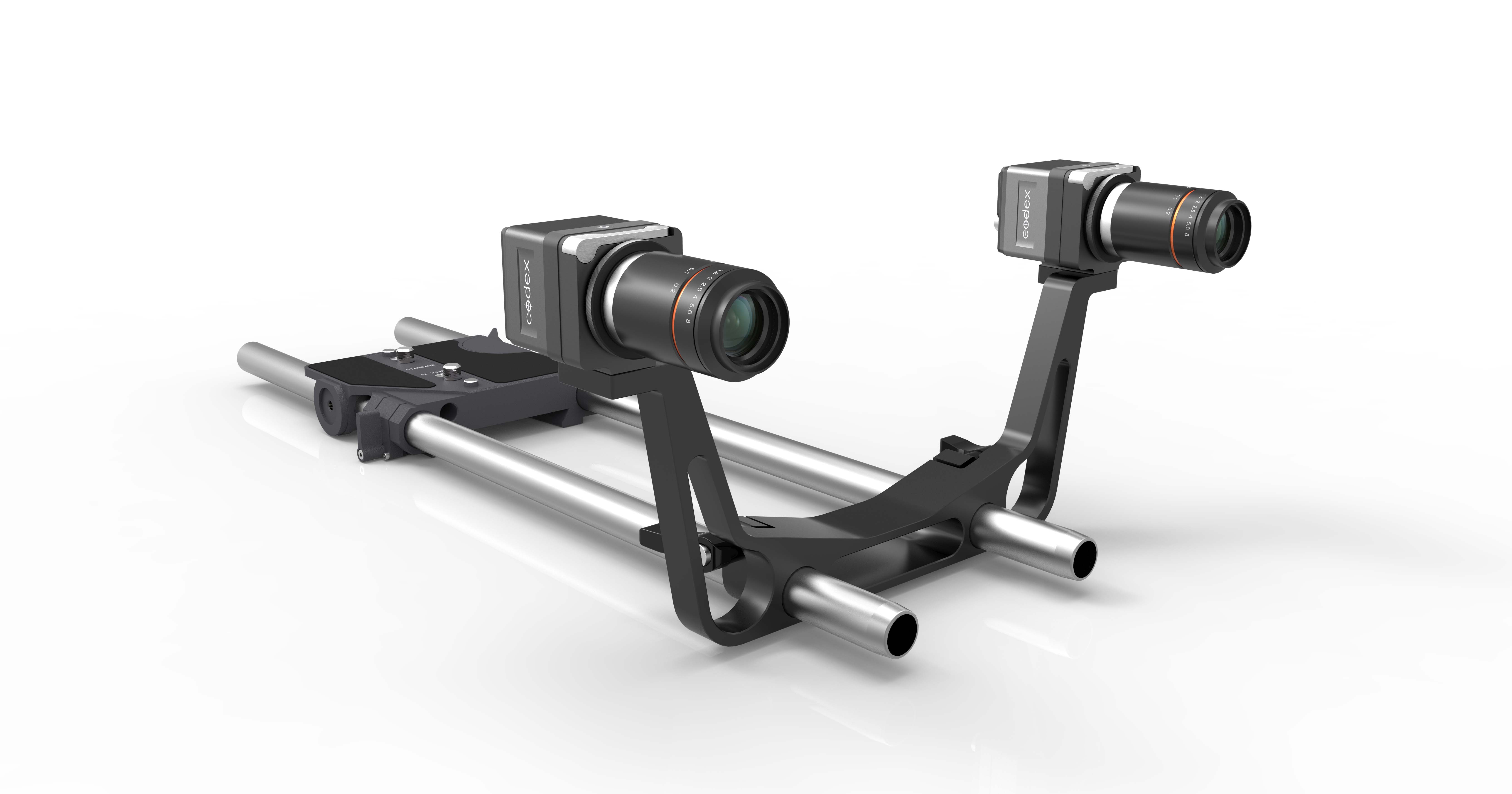
JVC is also introducing Professional Streaming Services, a cloud-based news management resource to complement its cameras with built-in IP integration. It is based around a new ProHD Broadcaster server powered by Zixi, and is claimed to make it easy and affordable to deliver live HD for web and broadcast. It can be a physical server or cloud-based system, receives the live HD video from any compatible JVC camcorders (such as the new GY-HM850 or upgraded GY-HM650), transcodes the signal for a variety of delivery platforms and should provide reliable transmission of the signal.
It will mean that delivery from the cameras to the internet merely requires entering a single IP address. Content can be directed to multiple destinations, including off-the-shelf HD-SDI decoders for live broadcast. With Broadcaster’s built-in matrix switching, it’s easy to manage signals for distribution, while automatic transcoding allows live, direct-to-web content delivery.
Broadcaster also provides a cost-effective way to provide multicamera coverage at an event without a production truck. Each camera feeds into and is identified by the server, which provides an output signal to the station’s decoder for air. Cameras can then be switched live. Broadcaster also accepts and transcodes video from Android and iOS devices, so users can take live video from a reporter with a smartphone.
JVC also launched the KMH-8000 StreamSuite portable webcasting production system. Its built-in switcher supports up to four wireless IP live HD video sources – it also supports wired cameras. It features: a 23-inch touch screen; titling and graphics overlay; audio mixer; live streaming output; HD-SDI and HDMI outputs; and internal MPEG recording to HDD.
JVC is suggesting that broadcasters can use the GW-GBLS1 at events or to cover news and record 4K internally while offering live aerial coverage in HD. Of course, there are restrictions on where UAVs can be used, but where permissions and safety procedures are in place it could offer a well-integrated way to get live aerial shots of an event while recording 4K for future use.
JVC is also developing two larger 4K cameras based on the same sensor: a shoulder-mount camera (GY-LSX1) with PL lens mount, that offers 4K at up to 60p and HD at up to 240p; and a compact handheld unit (GY-LSX2) using Micro Four Thirds lenses.
Ninja recording Star
The new Atomos Ninja Star is the world’s smallest ProRes recorder that should be ideal for use with PoV cameras or on remote-control helicopters.
“Our customers screamed for a tiny, flash-based Apple ProRes recorder and player for extreme applications, their second location cameras or simply when they already had a monitor,” explained Jeromy Young, CEO and founder of Atomos. “At $295 with low-cost Gen 1 CFast [solid state memory cards], weighing a mere 100g, its price, durability and portability is unmatched.”
It has HDMI input and is small enough (8.75cmx5.75cmx2cm) to work with action cameras that record internally only in MPEG or H.264, and offer edit-ready recording with Apple ProRes.
It can capture 10-bit 4:2:2 images to inexpensive first generation CFast media with up to almost three hours of Apple ProRes HQ (using a 256GB card – it also records ProRes 422 and LT). It also features frame-accurate timecode (via HDMI) and Start/Stop Trigger, thanks to co-operation from the leading camera manufacturers (Canon, Sony, Panasonic, Nikon and JVC). Audio can be taken direct from the camera on the two embedded digital channels or an external microphone can be added via the audio line in port for an extra two channels of analogue audio. It also has an HDMI out for use with an external monitor.
The battery is promised to last for about five hours, although it takes only one Sony camera battery instead of the dual battery ports seen on the bigger Ninja and Samurai recorders.
www.atomos.com
www.codexdigital.com
www.grassvalley.com
www.jvcpro.co.uk
www.minicams.tv
